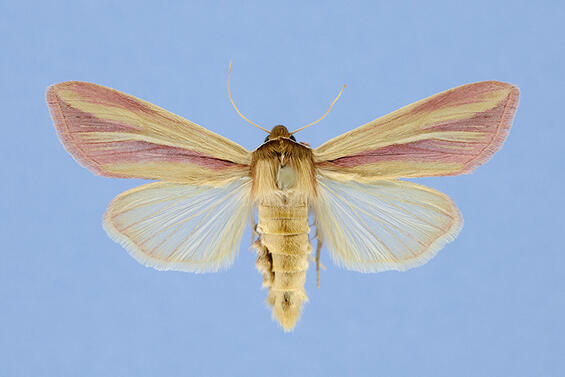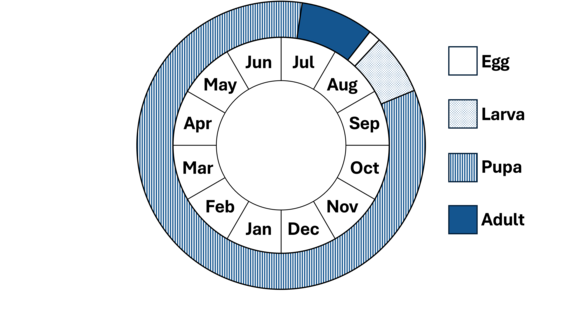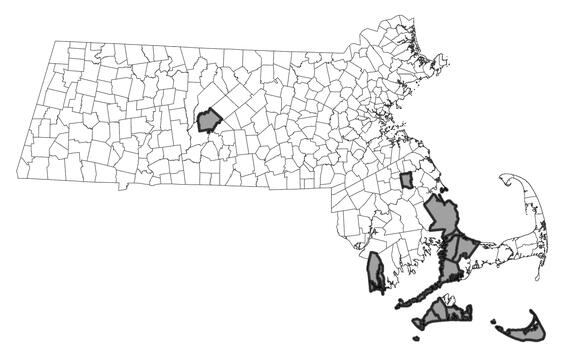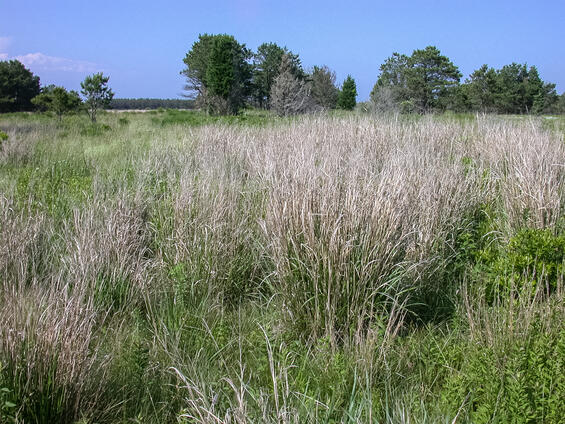- Scientific name: Dargida rubripennis
- Species of Greatest Conservation Need (MA State Wildlife Action Plan)
- Threatened (MA Endangered Species Act)
Description

Pink streak moth, Dargida rubripennis
The pink streak (Dargida rubripennis) is a noctuid moth with a wingspan of 32-37 mm (1.3-1.5 in) (Covell 1984). The forewing is light tan in color, with a bright pink streak that is narrow at the wing base, gradually broadening across the median area, and further broadening to encompass the entire outer margin; the streak is bisected by a cream-colored line along the cubital vein. The forewing has an additional pink streak along the outer one-third to one-half of the costal margin, and a black, narrow and elongate basal dash. The hind wing is a cream shade of white. The head, thorax, and abdomen are tan in color; the front of the thorax is frosted with white.
Life cycle and behavior

In Massachusetts, the pink streak moth flies from mid-July through early August. The preferred larval host plant is switchgrass (Panicum virgatum). Larvae feed primarily on the developing seeds of this grass, becoming fully grown by late August or early September. The pupa overwinters beneath the surface of the soil.
Distribution and abundance
The pink streak moth occurs from Massachusetts south to Florida, and west to Minnesota and Texas (Covell 1984). In Massachusetts, this species occurs along or near the coast, primarily in the southeastern part of the state, as well as in the Connecticut River Valley.

Distribution in Massachusetts.
1999-2024
Based on records in the Natural Heritage Database.
Habitat
In Massachusetts, the pink streak moth inhabits sandplain grasslands and dunes with switchgrass (Panicum virgatum), both along the coast and inland. Occasionally, it inhabits anthropogenic sandplain grasslands, for example at airports and along utility line rights-of-way.
Healthy habitats are vital for supporting native wildlife and plants. Explore habitats and learn about conservation and restoration in Massachusetts.

Sandplain grassland with switchgrass (Panicum virgatum), habitat for the pink streak moth. Habitat managed by the Massachusetts National Guard at Joint Base Cape Cod.
Threats
The pink streak moth is threatened by habitat loss and fire suppression in its disturbance-dependent habitats, specifically sandplain grasslands. Other potential threats include introduced generalist parasitoids, aerial insecticide spraying, non-target herbicide application, and off-road vehicles. This species previously reached the northeast extent of its range in southeastern Massachusetts. Over the past two decades, it has spread north into the Connecticut River Valley and along the coast north of Boston. While a warming climate may have enabled this range expansion, other aspects of climate change may be a threat. For example, many of the coastal habitats of this species are threatened by sea level rise.
Conservation
Land protection and habitat management are the primary conservation needs of this species in Massachusetts. In particular, sandplain grasslands should be conserved, restored, and managed to maintain habitat for this species and other species dependent on such habitat.
Survey and monitoring
The distribution of the pink streak moth in Massachusetts is well documented, though also expanding. Surveys should continue to document the shifting range of this species. Known populations of this species should be surveyed to document persistence at least once every 25 years; every 10 years is more desirable when practicable.
Management
Management of sandplain grasslands benefits a suite of rare species, and habitat condition should be monitored and management adapted as needed. For the pink streak moth, sandplain grassland with abundant switchgrass (Panicum virgatum) is of particular importance.
Research needs
The natural history and conservation needs of the pink streak moth are relatively well known. However, the future effects of climate change on this species are unpredictable and should be documented.
References
Covell, C.V. 1984. A Field Guide to Moths of Eastern North America. Peterson Field Guide Series. Houghton Mifflin, Boston, Massachusetts. 496 pp.
Contact
| Date published: | March 21, 2025 |
|---|